Recently I read The Sleepwalkers: How Europe Went to War in 1914 by Christopher Clark. It’s a fantastic history of the events leading up to World War I, and I highly recommend it, I think I spent just as much time looking people’s names up in the index and searching Wikipedia for events that aren’t covered in significant background in this book as I did actually reading it. Part of this may be because I have very little background in European history and geography (for example, it took me a while to internalize that Belgrade = Serbia and Sofia = Bulgaria), but a lot of it is because there are an enormous number of names in this text, and often names are thrown around with no context, forcing you to remember or look up what countries various diplomats are from and was this the Russian minister of war or of agriculture or something else?
So, I have compiled a list of important names, places, and events, along with links to Wikipedia pages about them. If you keep this open in a tab while reading this book, it should be helpful! Please note that I did not construct this as I was reading, but after, so it’s possible (likely) that I am missing some things. If you notice anything missing please let me know!
Diplomats before & during the July Crisis
This table only includes ambassadors, not anyone in an attaché role. In most cases, only the ambassador in office during the July Crisis (at the end of the book) is listed, but in some cases (notably Aehrenthal) a particular diplomat was very important earlier on, and in that case I’ve listed multiple names.
There were a few ambassadors to countries other than those I have listed, notably Italy and Bulgaria, but these are the major ones.
| From Country | To Serbia | To France | To Britain | To Russia | To Austria-Hungary | To Germany |
|---|---|---|---|---|---|---|
| Serbia | x | Milenko Radomar Vesnić | Miroslav Spalajković | Jovan Jovanović Pižon | ||
| France | Léon Descos1 | x | Paul Cambon2 | Maurice Paléologue | Théophile Delcassé | Jules Cambon2 |
| Britain | Dayrell Crackanthorpe | Francis Bertie | x | George Buchanan | Maurice de Bunsen | Edward Goschen3 |
| Russia | Nicholas Hartwig | Alexander Izvolsky | Alexander von Benckendorff | x | Nikolay Nikolayevich Shebeko4 | Sergei Nikolayevich Swerbeyev1 |
| Austria-Hungary | Wladimir Giesl von Gieslingen | Nikolaus Szécsen von Temerin | Albert von Mensdorff-Pouilly-Dietrichstein | Alois Lexa von Aehrenthal, Leopold Berchtold, Frigyes Szapáry | x | László Szőgyény-Marich Jr. |
| Germany | Wilhelm von Schoen | Prince Lichnowsky | Friedrich von Pourtalès | Heinrich von Tschirschky | x |
Heads of state & other relevant officials
| Country | Monarch or President | PM | Foreign minister | Other |
|---|---|---|---|---|
| Serbia | Peter I | Nikola Pašić | (also Pašić) | Dragutin Dimitrijević (Apis), Gavrilo Princip |
| France | Raymond Poincaré | René Viviani | (also Viviani) | |
| Britain | George V | H. H. Asquith | Edward Grey | Winston Churchill |
| Russia | Nicholas II | Ivan Goremykin, Vladimir Kokovtsov | Alexander Izvolsky, Sergey Sazonov | Alexander Krivoshein |
| Austria-Hungary | Franz Joseph I | Karl von Stürgkh (Austria), István Tisza (Hungary) | Leopold Berchtold | Franz Conrad von Hötzendorf (and Gina1!) |
| Germany | Wilhelm II | Theobald von Bethmann Hollweg | Gottlieb von Jagow | Alfred von Schlieffen, Helmuth von Moltke the Younger |
Important locations
Capital cities
- France - Paris
- Britain - London
- Russia - St. Petersburg
- Germany - Berlin
- Austria-Hungary - Vienna
- Serbia - Belgrade
- Romania - Bucharest
- Bulgaria - Sofia
Water routes
The Turkish Straits connect the Black Sea (Russia’s coastline) to the Aegean Sea and thus the Mediterranean Sea. The two straits are The Dardanelles (southwest, leading to the Aegean Sea) and the Bosphorus (northeast, leading to the Black Sea). In between them is the Sea of Marmara.
Here is a map, with the Bosphorus in red and the Dardanelles in yellow (courtesy of Wikipedia):

Some events you might want more information about
- The Agadir Crisis
- The First Balkan War and the Second Balkan War
- The Italo-Turkish War
- The First Boer War and the Second Boer War
- The Russo-Turkish War and its Treaty of Berlin
Wikipedia also has a nice little infobox listing the events leading to WW1, although it doesn’t contain everything mentioned in the text. I’ve left out a lot of events from this list that are discussed in detail in the book such as the Bosnian Annexation Crisis and the Sarajevo Assassination.5
A note on Wikipedia links
Where possible, I’ve linked to English-language Wikipedia articles, although there are a couple people who have articles in German/Russian but not English and I’ve linked the other language in these cases, marked with a footnote.
However, many of these figures have much more detailed pages in their country’s language, for example Krivoshein’s page in English is much shorter than his page in Russian.
You can find alternate translations like this in the old Vector skin:
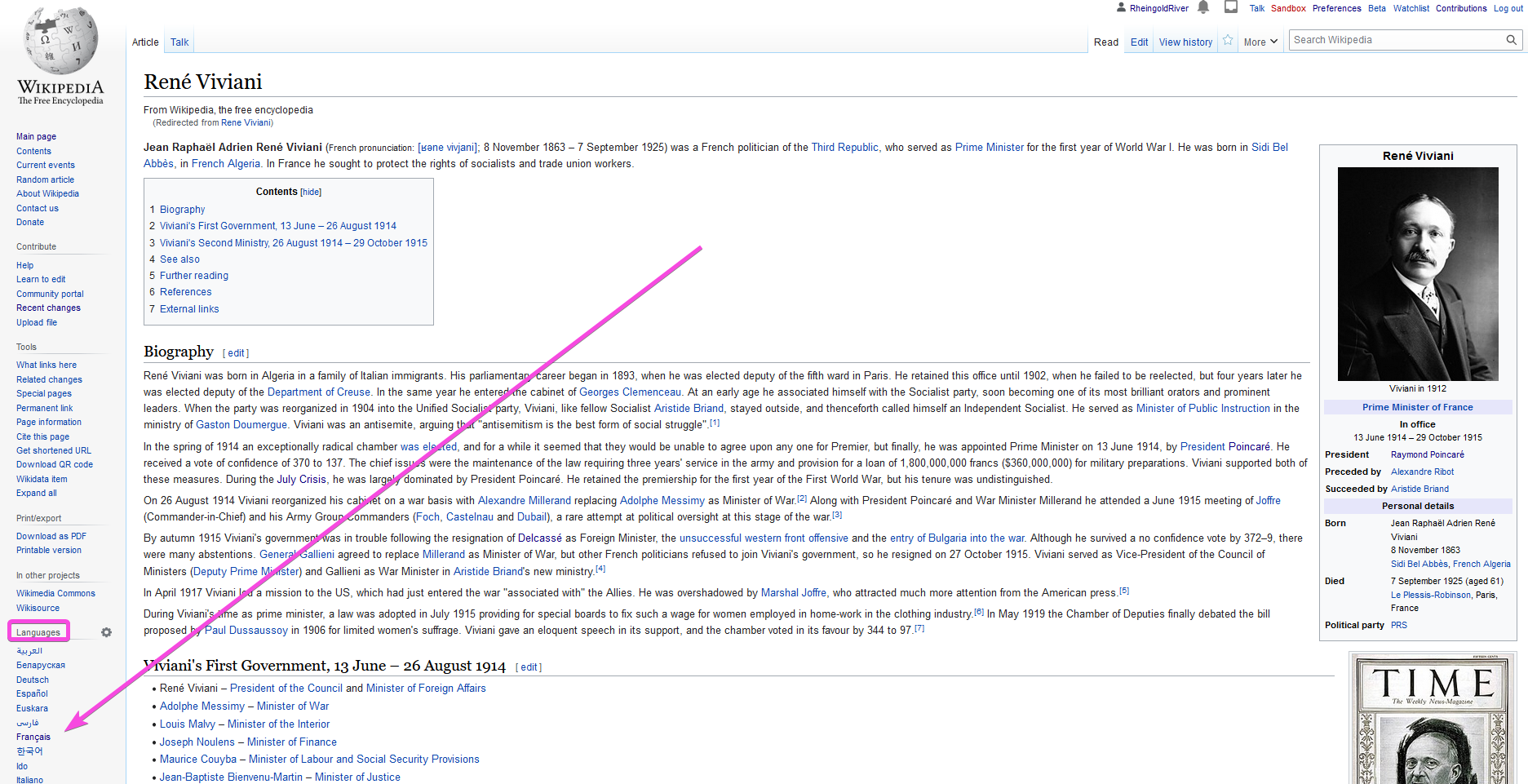
Or like this in the new Vector skin:
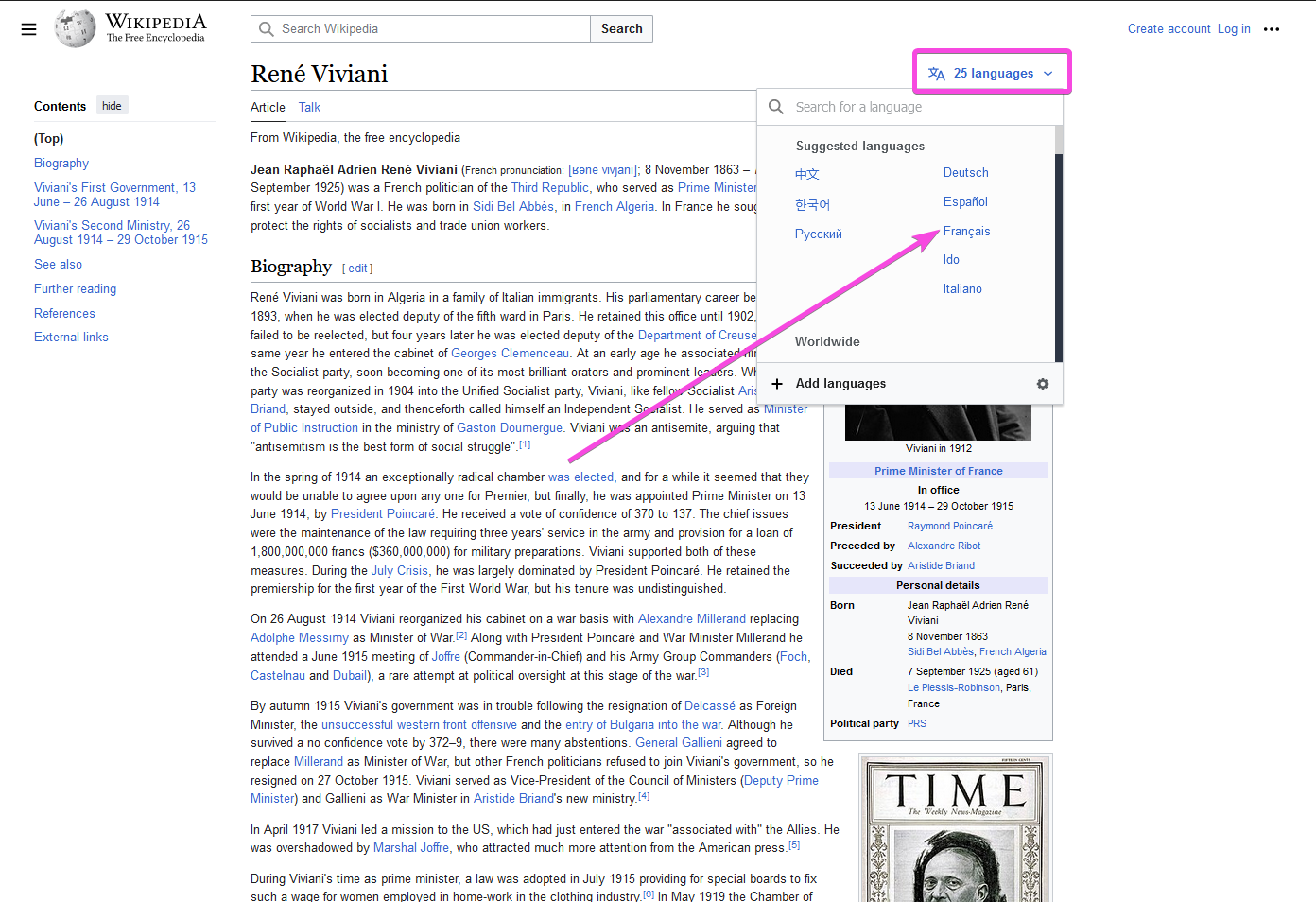
CSS language codes
If you are having trouble figuring out which link is which language then I suggest adding this CSS:
|
|

Or in new Vector:
|
|
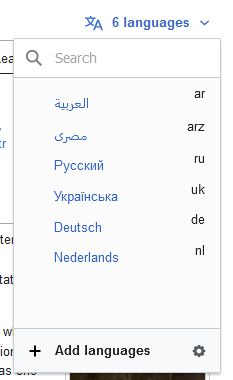
Or in new Vector you can also enable the gadget “SidebarTranslate” (this gadget only applies to Vector2022 skin and you have to be logged in).
Navigating via Wikidata
You can also go through Wikidata as follows:
In old Vector:
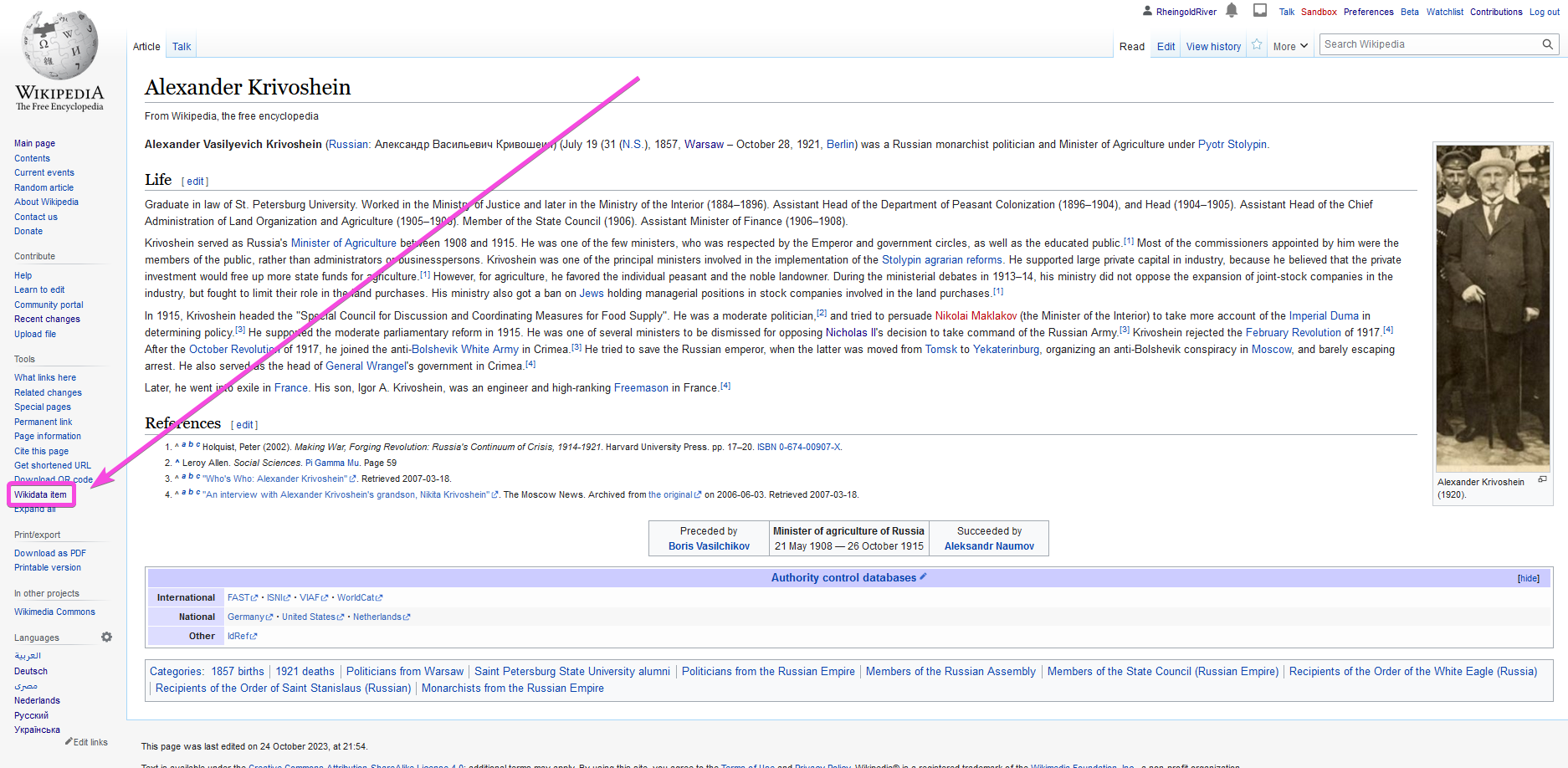
Or in new Vector:
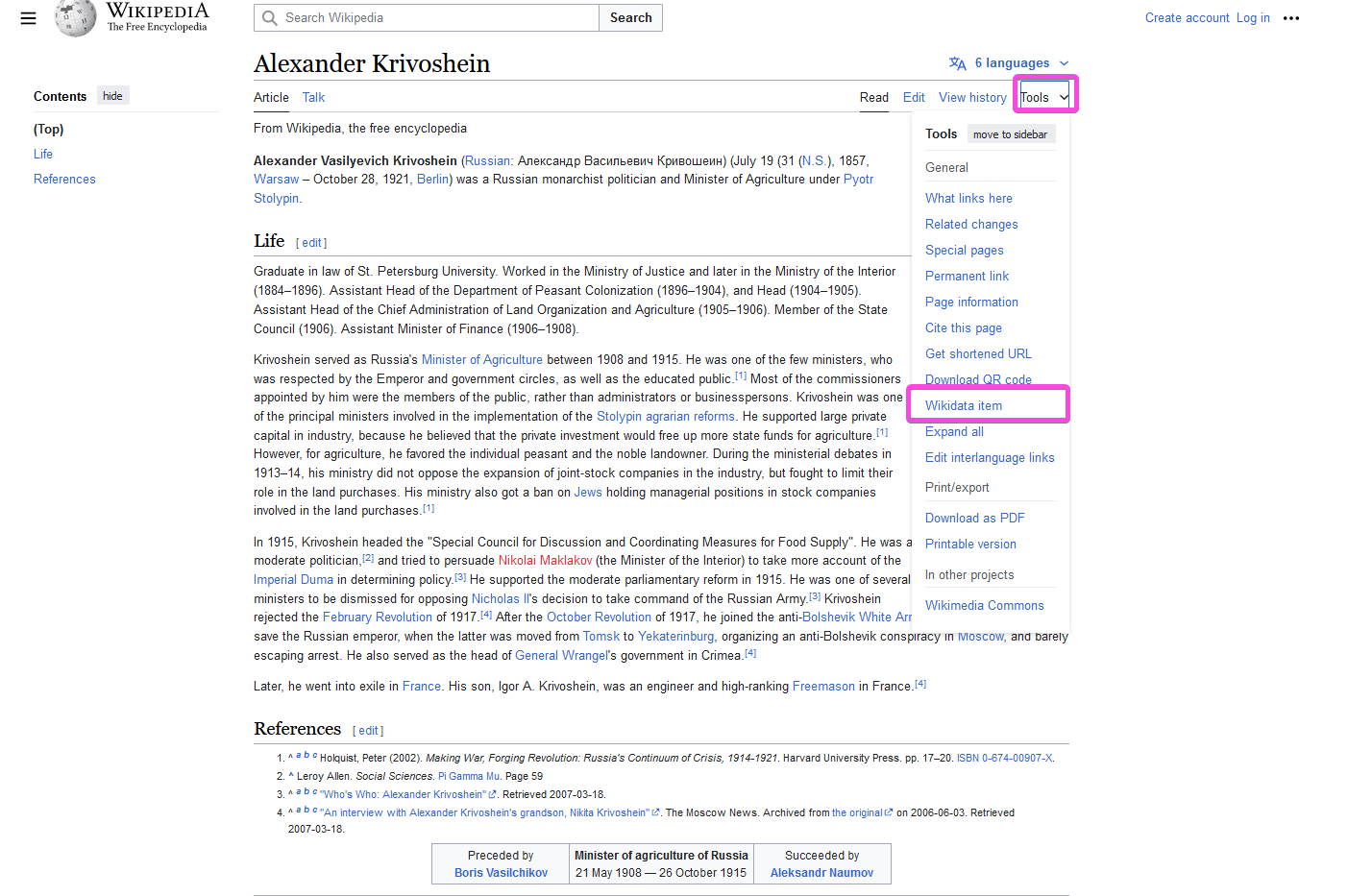
Then you can find the language you’re looking for in the list of Wikipedia pages in the upper-right-hand corner of the Wikidata page:

-
Link goes to de.wikipedia because there is no en.wikipedia page ↩︎ ↩︎ ↩︎
-
Not to be confused with his son, Edward Goschen, also a British diplomat ↩︎
-
Link goes to ru.wikipedia because there is no en.wikipedia page ↩︎
-
It’s also quite possible I’ve left off some events that should be in the list; as I said at the start, I’m writing this after reading and not while reading. ↩︎